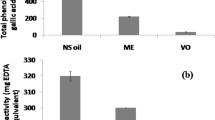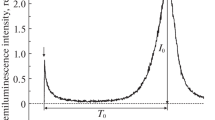Summary
Liposomal lipid peroxidation and peroxide induced DNA damage were investigated. Inhibition of lipid peroxidation was studied using 400 µM uric acid, β-carotene, ∝-tocopherol, curcumin and butylated hydroxyanisole (BHA). Curcumin, the active principle of turmeric (Curcuma longa), was as effective an antioxidant as BHA. An aqueous extract of turmeric was also found to be an effective inhibitor. The inhibition obtained using this aqueous extract, incorporated into the liposome itself, was 70% at 300 ng/µ1 This indicates the presence of yet another antioxidant in turmeric besides the lipophilic curcumin. The aqueous antioxidant extended 80% protection to DNA against peroxidative injury at 100 ng/µl. This component of turmeric is being characterised and investigated as an antioxidant/anticlastogen and as an antipromoter.
Similar content being viewed by others
Abbreviations
- GT1b:
-
Trisialoganglioside
- TBS:
-
Tris Buffered Saline
- PBS:
-
Phosphate Buffered Saline
- TBA:
-
Thio Barbituric acid
- BHA:
-
Butylated Hydroxy Anisole
- EDTA:
-
Ethylene Diamine Tetra Acetic Acid
References
Kobayashi T, Itabe H, Inoue K, Nojima S: Peroxidation of liposomes in the presence of human erythrocytes and induction of membrane damage of erythrocytes by peroxidised liposomes. Biochim Biophys Acta 814:170–178, 1985
Lesko SA, Tso POP, Yang, S-U, Zheng R: Benzo(a)pyrene radicals and oxygen radical involvement in DNA damage; Cellular toxicity and Carcinogenesis. In: McBrien DCH, Slater TF (eds) Free Radicals, Lipid Peroxidation and Cancer. Academic Press: 1982, pp 401–420
Nair V, Cooper CS, de Vietti, Turner GA: The chemistry of lipid peroxidation metabolites: crosslinking reactions of malonaldehyde. Lipids 21:6–10, 1986
Summerfield FW, Tappel AL: The determination of malonaldehyde-DNA crosslinks by fluorescence and incorporation of tritium. Anal Biochemi 11:77–82, 1981
Emeritt I, Cerutti PA: Tumour promoter phorbol-12-myristate-13-acetate induces a clastogenic factor in human lymphocytes. Proc Natl Acad Sci USA 79:7509–7513, 1982.
Davies KJA, Quantanilha AT, Brooks GA, Packer L: Free radicals and tissue damage produced by exercise. Biochem Biophys Res Common 107:1198–1205, 1982
Totter JR: Spontaneous cancer and its relationship to oxygen metabolism. Proc Natl Acad Sci USA 77:1763–1767, 1980
Mukai FH, Goldstein BD: Mutagenecity of malonaldehyde, a decomposition product of peroxidised polyunsaturated fatty acids. Science 191:868–869, 1976
Shimura J, Shimura H, Hosoya N: Functional disability of rat splenocytes provoked to lipid peroxidation by cumene hydroperoxide. Biochim Biophys Acta 845:43–47, 1985
Cerutti PA: Prooxidant states and tumour promotion. Science 227:375–381, 1985
Gindhart TD, Srinivas L, Colburn NH: Benzoyl peroxide promotion of transformation of JB6 mouse epidermal cells: inhibition by ganglioside GT but not retinoic acid. Carcinogenesis 6:309–311, 1985
Watts P: BHA isomers and hyperplasia. Food Chem Toxicol 23:639–640, 1985
Ito N, Fukushima S, Tsuda H, Shirai T, Hagiwara A, Imaida K: Antioxidants: Carcinogenecity and modifying activity in tumorigenesis. In: Gibson GG, Walker R (eds). Food Toxicology: Real or Imaginary problems? Taylor & Francis, Great Britain: 1985, pp 181–198
Sharma OP: Antioxidant activity of curcumin and related compounds. Biochem J Pharmacol 26:1811–1812, 1976
Salimath BP, Sundaresh CS, Srinivas L: Dietary components inhibit lipid peroxidation in erythrocyte membranes. Nutr Res 6:1171–1178, 1986
Vijayalakshmi R, Chardrasekhara N: Metabolism of curcumin. Studies with (3H) curcumin. Toxicology 22:337–344, 1982
Szoka F, Papahadjopoulos D: Procedure for preparation of liposomes with large internal aqueous space and high capture by reverse phase evaporation. Proc Natl Acad Sci USA 75:4194–4198, 1978
Shimasaki H, Ueta N, Mowri H-O, Inoue K: Formation of age pigment-like fluorescent substances during peroxidation of lipids in model membranes. Biochim Biophys Acta 792:123–129, 1984
Dahle LK, Hill EG, Holman RT. The thiobarbituric acid reaction and the autooxidations of polyunsaturated fatty acid methyl esters. Arch Biochem Biophys 98:253–261, 1962
Stoffel W, Ahrens EH: Isolation and structure of the C16-unsaturated fatty acids in Menhaden body oil. J Am Chem Soc 80:6604–6608, 1958
Ames BN, Cathcart R, Schwiers E, Hochstein P: Uric acid provides an antioxidant defense in humans against oxidant and radical-caused aging and cancer: A hypothesis. Proc Natl Acad Sci USA 78:6858–6862, 1981
Fukuzawa K, Takase S, Tsukatami H: The effect of concentration on the antioxidant effectiveness of a-tocopherol in lipid peroxidation induced by superoxide free radicals. Arch Biochem Biophys 240: 117–120, 1985
Terao J, Sugino K, Matsushita S: Fe+1 and ascorbic acid-induced oxidation of cholesterol in phosphatidyl choline liposomes and its inhibition by α-tocopherol. J Nutr Sci Vitaminol 31:499–508, 1985
Packer JE, Mahood JS, Arellano YOM, Slater TF, Willson RE, Wolfenden BS: Free radicals and singlet oxygen quenchers. Reaction of peroxy-radical with β-carotene, diphenyl furan and 1,4-diazobicyclo (2,2,2)—octane. Biochem Biophys Res Commun 98:901–906, 1981
Fujimoto K, Neff WE, Frankel EN: The reaction of DNA with lipid oxidation products, metals and reducing agents. Biochim Biophys Acta 795:100–107, 1984
Nakamura Y, Colburn NH, Gindhart TD: Role of reactive oxygen in tumor promotion: Implication of superoxide anion in promotion of neoplastic transformation in JB6 cells by TPA. Carcinogenesis 6: 229–235, 1985
Amstad P, Levy A, Emerit I, Cerutti PA: Evidence for membrane-mediated chromosomal damage by aflatoxin B1 in human lymphocytes. Carcinogenesis 5:709–723, 1984
Stocker R, Yamamoto Y, McDonagh AF, Glazer AN, Ames BN: Bilirubin is an antioxidant of possible physiological importance. Science 235:1043–1046, 1987
Logani MK, Davis RE: Lipid oxidation: Biologic effects and antioxidants: A review. Lipids 15:485–493, 1979
Birnboim HC: DNA strand breakage in human leukocytes exposed to a tumour promoter, phorbol myristate acetate. Science 215:1247–1249, 1982
Klein-Szanto AJP, Slaga TJ: Effectd of peroxides on rodent skin: epidermal hyperplasia and tumour promotion. J Invest Dermatol 79:30–34, 1982
Hariharan PV, Cerutti PA: Formation of products of the 5,6-dihydroxyhydrothymine type by ultraviolet light in He La cells. Biochemistry 16:2791–2795, 1977
Demple B, Linn S: 5,6-saturated thymine lesions in DNA: production by UV light or hydrogen peroxide. Nucleic Acids Res 10:3781–3789, 1982
Murray V, Martin RF: The sequence specificity of bleomycin induced DNA damage in intact cells. J Biol Chem 160:10389–10391,1985
Lown JW. Ethidium binding assay for reactive oxygen species generated from reductively activated adriamycin (doxorubicin). Methods in Enzymology 105:532–539, 1984
Author information
Authors and Affiliations
Rights and permissions
About this article
Cite this article
Shalini, V.K., Srinivas, L. Lipid peroxide induced DNA damage: protection by turmeric (Curcuma longa). Mol Cell Biochem 77, 3–10 (1987). https://doi.org/10.1007/BF00230145
Received:
Accepted:
Issue Date:
DOI: https://doi.org/10.1007/BF00230145




